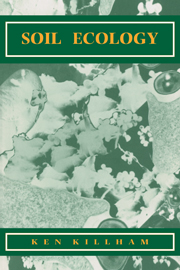Book contents
- Frontmatter
- Dedication
- Contents
- Foreword
- Introduction
- 1 The soil environment
- 2 The soil biota
- 3 Ecological interactions between the soil biota
- 4 The ecology of soil nutrient cycling
- 5 Ecology of extreme soil environments - soil water stress
- 6 Ecology of polluted soils
- 7 Manipulation of soil ecology - ‘soil biotechnology’
- References
- Further reading
- Index
4 - The ecology of soil nutrient cycling
Published online by Cambridge University Press: 12 October 2018
- Frontmatter
- Dedication
- Contents
- Foreword
- Introduction
- 1 The soil environment
- 2 The soil biota
- 3 Ecological interactions between the soil biota
- 4 The ecology of soil nutrient cycling
- 5 Ecology of extreme soil environments - soil water stress
- 6 Ecology of polluted soils
- 7 Manipulation of soil ecology - ‘soil biotechnology’
- References
- Further reading
- Index
Summary
INTRODUCTION
Many of the important nutrients in the life cycle of plants, animals and microorganisms are cycled in the soil between the soil organic matter and the inorganic nutrient pool. These so-called ‘biological elements’ such as carbon, nitrogen, sulphur and phosphorus form the main building blocks of cellular tissue and are initially absorbed by the lower forms of life as simple inorganic forms and are then converted to organic constituents within the cell. The death and decay of organisms and their tissues results in release of inorganic ions and, so, a cycle is established.
From the onset, it is essential to appreciate that nutrient cycling involves the activity of plants, microbes and animals. Many texts on nutrient cycling have tended to neglect one or two of these components, particularly the soil animals. This chapter attempts to provide a more balanced picture of the ecology of soil nutrient cycling.
THE CARBON CYCLE
Introduction - the global carbon cycle
Recent concern over the possible consequences of increasing concentrations of carbon dioxide in the atmosphere (part of the greenhouse effect), largely as a result of the burning of fossil fuels and the clearing/burning of large areas of forest, has created renewed interest in developing a full understanding of the global carbon cycle.
Apart from the burning of fossil fuels and forest fires, carbon dioxide is continually produced by all heterotrophs in the biosphere. On the other hand, carbon dioxide is fixed by autotrophs, particularly through the process of photosynthesis. Figure 5 in Chapter 1 illustrates this relationship between heterotrophy and autotrophy.
Although the total global reservoir of carbon is vast (more than 1016 t), only a small fraction of this carbon is actively involved in the fluxes of the carbon cycle, most of the earth's carbon being ‘locked away’ in sediments (mainly as carbonates), in carbonate in ocean waters, and in igneous rocks and fossil carbon. Putting the burning of fossil fuels to one side, the earth's active carbon fraction largely consists of carbon in living organisms, carbon in the organic matter of the soil and carbon in the atmosphere. The soil carbon pool is approximately five times the size of the atmospheric pool. The latter is approximately the same size as that in living organisms. These three pools together, however, amount to less than one thousandth of global carbon reserves.
- Type
- Chapter
- Information
- Soil Ecology , pp. 89 - 150Publisher: Cambridge University PressPrint publication year: 1994
- 5
- Cited by



